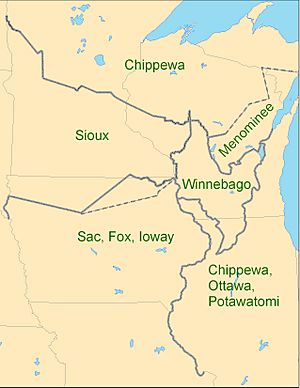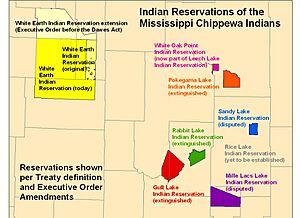Mississippi River Band of Chippewa Indians facts for kids
The Mississippi River Band of Chippewa Indians (called Gichi-ziibiwininiwag in their language) were a group of Ojibwe people. They lived near the start of the Mississippi River and its smaller rivers in what is now Minnesota.
Their stories say they were part of the southern Ojibwe. They moved from Baawiting (the Sault Ste. Marie area) along Lake Superior. They reached the Saint Louis River. From there, they traveled west across the Savanna Portage. They then spread north and south along the Mississippi River and its main branches.
Before making treaties with the United States, the Mississippi Chippewa included many smaller groups. These groups were:
- Cedar Lake, Minnesota Band
- Crow Wing, Minnesota Band
- Gull Lake, Minnesota Band
- Mille Lacs, Minnesota Band
- Pelican Lake, Minnesota Band
- Pokegama Lake, Minnesota Band
- Rabbit Lake, Minnesota Band
- Rice Lake, Minnesota Band
- Sandy Lake, Minnesota Band
- Snake River Band
- Swan River Band
- Trout Lake, Minnesota Band
- White Oak Point, Minnesota Band
These groups controlled the main trade route along the Mississippi River's headwaters. Their traditional lands included the part of the Mississippi River between the Leech Lake River and the Crow Wing River. This area was known in the Ojibwe language as Gichi-ziibi (Big River). It also included the Brainerd Lakes Area.
Contents
History and Treaty Making
In 1825, the United States created the Prairie du Chien Line with the First Treaty of Prairie du Chien. This line was meant to separate the Ojibwe from the Dakota people. The US believed these groups were still fighting. However, the Ojibwe and Dakota had mostly stopped their wars by then.
In 1830, the Indian Removal Act was signed by President Andrew Jackson. This law gave the president power to make Native American tribes move to lands west of the Mississippi River. You can learn more about this act in important American history documents [1].
The Mississippi Chippewa, along with other bands, signed the Treaty of St. Peters in 1837 with the US. They gave up land that is now part of northern Wisconsin and east-central Minnesota.
The Sandy Lake Tragedy
In 1850, the US government changed where they gave out payments to the tribes. They moved it from La Pointe, Wisconsin to Sandy Lake. This was an effort to make the tribes move further west. About 4,000 Ojibwe people arrived at Sandy Lake in early October. But no government agents or supplies were there.
The Ojibwe waited for two months in bad weather. During this time, 170 Ojibwe people died. When the government finally brought supplies, the weather was very harsh. Another 230 Ojibwe died on their way back home. This sad event became known as the Sandy Lake Tragedy.
Because of the Sandy Lake Tragedy, the Mississippi Chippewa and the Pillager Band of Chippewa Indians signed the Treaty of Washington in 1855. They gave up most of northern Minnesota to the United States. In return, the US promised three reservations for the Pillagers and six for the Mississippi Chippewa. The tribes also kept their right to hunt and fish on lands outside the reservations. This right was forgotten for a while but was brought back later. An example is the Wisconsin Walleye War in the late 1980s.
The six reservations promised to the Mississippi Chippewa were:
- Gull Lake Indian Reservation
- Mille Lacs Indian Reservation
- Pokegama Lake Indian Reservation
- Sandy Lake Indian Reservation
- Rabbit Lake Indian Reservation
- Rice Lake Indian Reservation
Confusion Over Rice Lake Reservation
The Rice Lake Indian Reservation was never officially set up. This was due to confusing records kept by the US Bureau of Land Management. Several lakes near Sandy Lake had names that meant "Rice Lake" in English. This caused confusion about where the reservation should be. The issue was never solved.
The Rice Lake Band said that the proposed locations were all wrong. They believed their agreed-upon reservation was much farther south.
Dakota War and Resettlement
During the Dakota War of 1862 against European-American settlers, some Chippewa bands helped the Dakota people. However, the Sandy Lake Band stayed neutral.
Chief Máza-mani (Iron-Walker) of the Mille Lacs Indians learned that Chief Bagone-giizhig (Hole-in-the-Day) of the Gull Lake Band planned to attack Fort Ripley. Máza-mani gathered 200 men to help the Americans. They reached the fort and helped defend it before Chief Bagone-giizhig arrived. This stopped the attack. Both the Sandy Lake and Mille Lacs bands gained protection from the United States because of their actions.
All other Mississippi Chippewa were forced to move from their reservations. They were sent to areas around the Leech Lake and Lake Winnibigoshish reservations. Because of problems between the moved Mississippi Chippewa and the local bands, the Mississippi Chippewa talked with the United States about moving again.
The Pokegama Lake Band and some of the Sandy Lake Band stayed in the area. They eventually formed the White Oak Point Band on the White Oak Point Reservation. In 1934, this band joined with others to form the modern Leech Lake Band of Ojibwe and its reservation.
With the 1867 Treaty of Washington, the remaining Mississippi Chippewa near Leech Lake agreed to move west. This led to the creation of the White Earth Reservation. In the 1900s, these bands combined to form the modern White Earth Band of Chippewa.
The US government wanted Native lands for logging and farming. They saw the White Earth Reservation as a solution to the "Chippewa Problem." They strongly pushed the Mille Lacs and remaining Sandy Lake bands to move there. Many did, becoming the "Removable" people. Those who stayed in their traditional lands became the "Non-removable" people.
In 1867, a treaty was signed between the Chippewa of the Mississippi tribe and the United States government. This treaty dealt with farming and logging land that the Native Americans received. You can find details about this treaty online [2]. Charles J. Kappler, who wrote this article, was important in passing this treaty. He also brought Native American law cases to the US Supreme Court [3].
Successor Bands Today
The "Treaty with the Chippewa, 1855" [4] means that people from the Mille Lacs Band of Ojibwe and White Earth Band of Chippewa still receive benefits today. Article 3 of the treaty says the US agreed to pay and provide for these bands.
Even though the Mississippi River Band of Chippewa Indians no longer exists as a legal group, most members of the Mille Lacs Band of Ojibwe and White Earth Band of Chippewa still identify as Mississippi Chippewa. The groups that continue the legacy of the Mississippi Chippewa are:
Burial Mounds
Burial mounds are a very old and important tradition for Indigenous people, including the Mississippi Band of Chippewa Indians. These mounds are sacred cemeteries where their ancestors are buried. They are places for respect, remembrance, and prayer.
Timothy Pauketat's article in "Dictionary of American History" explains how some Native American burial mounds have been found and identified [5].
One example of a preserved sacred mound is the Grand Mound Historic Site near International Falls, Minnesota [6]. This site is one of 25 National Historic Landmarks in Minnesota. Kent Whitworth, director of the Minnesota Historical Society, said, "The historical importance of this site cannot be understated. We must protect it and provide education while also ensuring that Native people can care for the place where their ancestors lie."
Because these sites are so important to Native American people, states have worked to preserve them. The Effigy Mounds National Monument in Iowa is another example of this effort [7].



